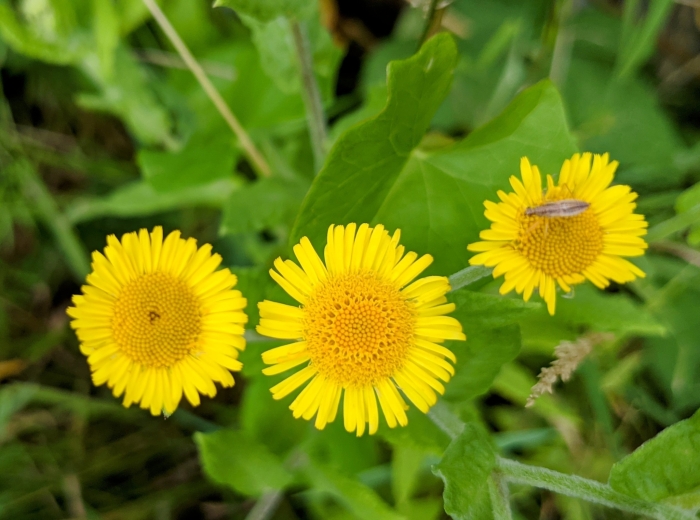Common Fleabane
(Pulicaria dysenterica)
Common Fleabane (Pulicaria dysenterica)
/
/

J Castillo
CC BY 4.0
Image By:
J Castillo
Recorded By:
Copyright:
CC BY 4.0
Copyright Notice:
Photo by: J Castillo | License Type: CC BY 4.0 | License URL: http://creativecommons.org/licenses/by/4.0/ | Rights Holder: J Castillo | Publisher: iNaturalist | Date Created: 2021-08-04T15:45:21-07:00 |
















Estimated Native Range
Summary
Pulicaria dysenterica, commonly known as Common Fleabane, is a perennial herb native to a variety of habitats including damp grasslands, riverbanks, and roadsides across Europe and western Asia. It typically grows up to 2 feet tall and forms dense clusters. The plant features yellow inflorescences composed of numerous disc and ray florets that bloom from late summer to early autumn, providing a late-season nectar source for pollinators. The flowers are modest in size but can be quite showy when in large numbers due to their bright color.
Common Fleabane is valued for its historical medicinal uses and its role in supporting wildlife, particularly as the main food plant for the fleabane tortoise beetle and several micromoth species. It is often used in wildflower meadows, naturalistic plantings, and alongside ponds or streams where its moisture-loving nature is an asset. It prefers full sun to part shade and grows best in moist, well-drained soils. While generally low-maintenance, it can be susceptible to powdery mildew in dry conditions. It is not known for being invasive and does not typically present problems with aggressive roots or diseases.CC BY-SA 4.0
Common Fleabane is valued for its historical medicinal uses and its role in supporting wildlife, particularly as the main food plant for the fleabane tortoise beetle and several micromoth species. It is often used in wildflower meadows, naturalistic plantings, and alongside ponds or streams where its moisture-loving nature is an asset. It prefers full sun to part shade and grows best in moist, well-drained soils. While generally low-maintenance, it can be susceptible to powdery mildew in dry conditions. It is not known for being invasive and does not typically present problems with aggressive roots or diseases.CC BY-SA 4.0
Plant Description
- Plant Type: Herb
- Height: 1.5-2.5 feet
- Width: 1-1.5 feet
- Growth Rate: Moderate
- Flower Color: Yellow
- Flowering Season: Summer, Fall
- Leaf Retention: Deciduous
Growth Requirements
- Sun: Full Sun, Part Shade
- Water: Medium
- Drainage: Medium
Common Uses
Bee Garden, Border Plant, Butterfly Garden, Low Maintenance
Natural Habitat
Damp grasslands, riverbanks, and roadsides across Europe and western Asia
Other Names
Common Names: Common Fleabane, Stinking Fleabane, Fleabane
Scientific Names: , Pulicaria dysenterica, Inula conyzae, Inula conyzoea, Pulicaria dysenterica, Pulicaria dysenterica var. dysenterica, Pulicaria repens, Pulicaria repens,
GBIF Accepted Name: